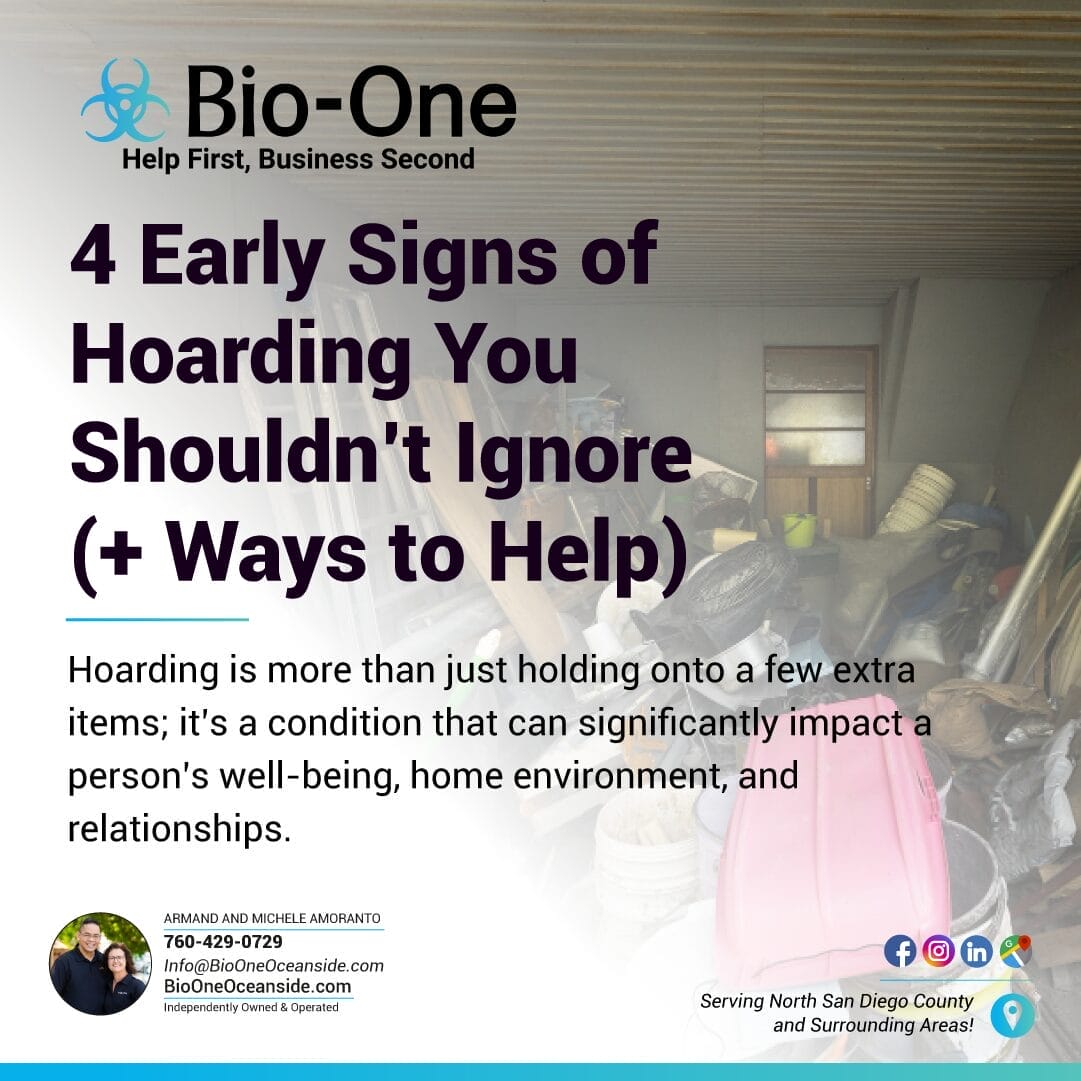
Hoarding disorder often starts subtly, with small changes that can go unnoticed. Unfortunately, left unaddressed, it can escalate into a serious issue that affects mental health, personal relationships, and living environments. Recognizing the early signs of hoarding is crucial, as early intervention can make a significant difference.
If you or someone you care about is showing these behaviors, it’s essential to approach the situation with empathy and understanding. This blog will help you identify the early signs of hoarding and provide actionable steps to support someone who may be struggling.
Hoarding is more than just keeping a messy house or having trouble letting go of sentimental items. It’s a complex mental health condition often rooted in anxiety, depression, or trauma. Hoarding can hinder daily living, compromise safety, and damage relationships.
Recognizing these behaviors early can allow for timely intervention, reducing the emotional and physical burdens that later stages of hoarding might cause.
One of the hallmark signs of hoarding is the emotional attachment to belongings, even those that seem insignificant or useless (e.g., old newspapers, expired coupons, broken gadgets).
Why this matters:
This behavior often stems from the fear of losing something valuable or making the wrong decision. The person may feel guilt, anxiety, or even sadness when considering getting rid of these items.
How to help:
People struggling with hoarding often collect and retain large quantities of items without having a clear reason for doing so. These items can include clothes, mail, food containers, or even free promotional gifts.
Why this matters:
Accumulation typically begins gradually. The person may believe these items “could be useful someday,” even if there’s no realistic need for them. Over time, unused piles can grow, making spaces unusable and creating hazards.
How to help:
One of the earliest visible symptoms of hoarding is when living spaces—such as countertops, tables, or even bathtubs—start to fill up with clutter. This can make it difficult to move freely or use areas as intended.
Why this matters:
The clutter may seem manageable initially, but as it grows, it can restrict day-to-day activities, increase safety risks (such as falls or fire hazards), and cause embarrassment, leading the person to isolate themselves socially.
How to help:
Individuals in the early stages of hoarding might start canceling plans or avoiding visitors due to embarrassment about their living conditions. What might feel like an isolated choice could actually reflect deeper feelings of guilt, anxiety, and shame.
Why this matters:
Isolation can exacerbate the emotional difficulties that contribute to hoarding, creating a harmful cycle where the clutter worsens and the person becomes even more withdrawn.
How to help:
Understanding and compassion are key when helping someone who may be struggling with hoarding. Here are some strategies to offer meaningful support:
Learning more about hoarding disorder can help you approach the situation with informed empathy. Understanding that this is a mental health condition—and not just "messiness" or "laziness"—can guide your responses.
A therapist or counselor who specializes in hoarding disorder or cognitive behavioral therapy (CBT) can provide valuable assistance. Hoarding cleanup professionals can also be a great resource in safely restoring living spaces.
Big projects can feel overwhelming. Celebrate each step forward, no matter how small. Whether it’s clearing out one corner or recycling a single bag of items, progress builds momentum.
Pressuring someone to declutter quickly can lead to mistrust or increased anxiety. Instead, prioritize their emotional needs and work at their pace.
If the situation feels too overwhelming, know that you’re not alone in addressing it. Professional hoarding cleanup services can provide discreet, compassionate help to restore a safe and functional living environment. These teams understand the emotional challenges of hoarding and work to create a respectful and judgment-free experience.
At Bio-One of Oceanside, we specialize in hoarding cleanup with unmatched care and professionalism. Our goal is to lift the load—both physical and emotional—while preserving your or your loved one’s dignity.
Early intervention can make a lasting difference for someone struggling with hoarding tendencies. Recognizing the signs and offering compassionate support can go a long way in helping them regain control of their home and quality of life.
If you or a loved one needs help, don’t hesitate to reach out. Contact Bio-One of Oceanside and Bio-One of South OC today for expert assistance from people who truly care.
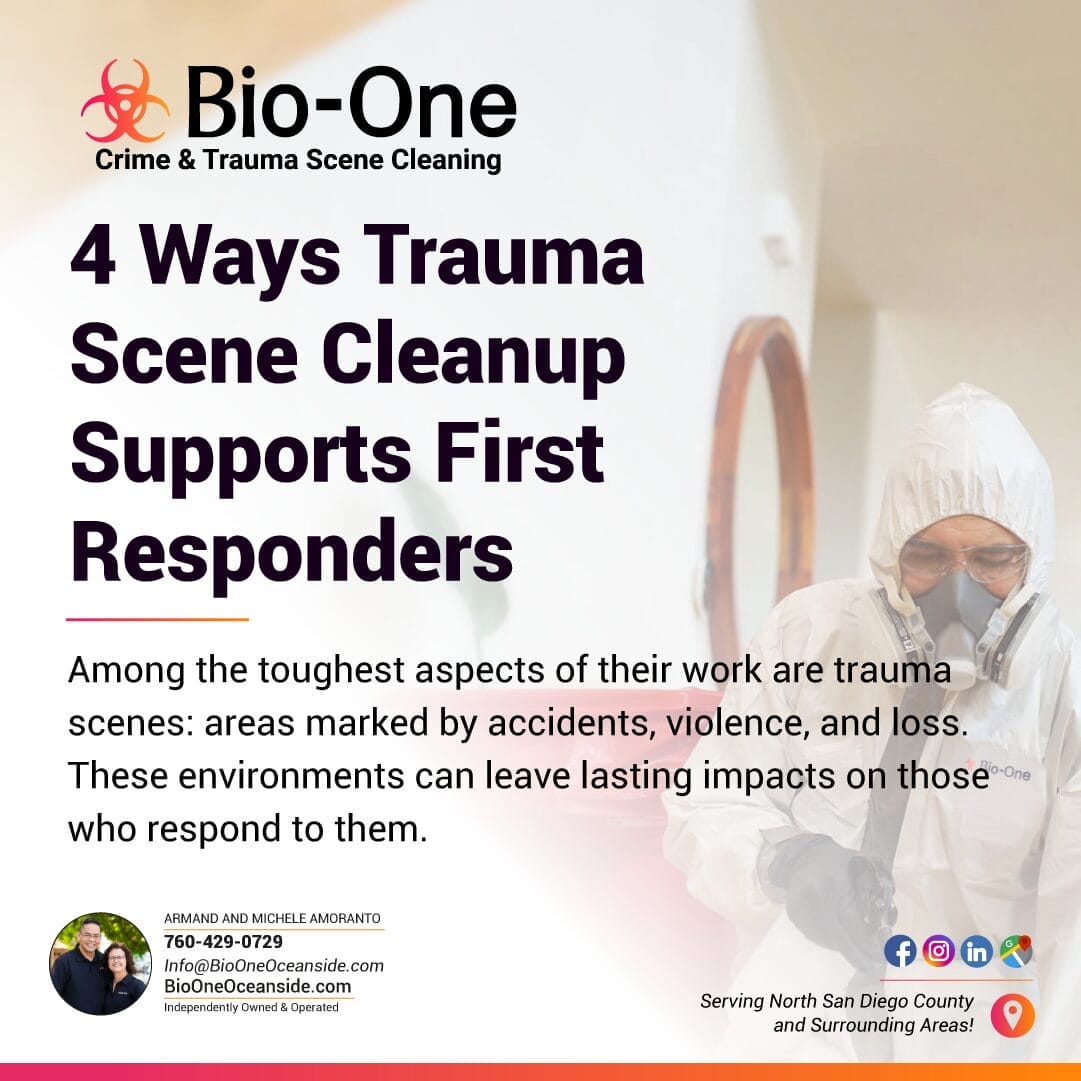
First responders are everyday heroes who face extraordinary challenges. Whether extinguishing a fire, providing emergency medical care, or securing a crime scene, they encounter situations that test them physically and emotionally. Among the toughest aspects of their work are trauma scenes—areas marked by accidents, violence, and loss. These environments can leave lasting impacts on those who respond to them. One vital, though often overlooked, factor that can help alleviate these challenges is professional trauma scene cleanup.
Here are four critical ways trauma scene cleanup supports first responders, ensuring their safety, health, and ability to continue serving their communities with resilience.
Trauma scenes often contain biohazards such as blood, bodily fluids, or other potentially infectious materials. Without proper cleanup, these hazards can pose significant health risks, exposing first responders to diseases like hepatitis or HIV. Most first responders have limited training in handling these contaminants safely.
Professional cleanup teams, on the other hand, are equipped with industrial-grade disinfectants, protective gear, and specialized techniques. By eliminating pathogens and restoring safety to the environment, trauma cleanup services prevent harmful exposure, allowing first responders to focus on their roles without worrying about unseen dangers.
Witnessing a traumatic event is already an emotional burden for first responders. Having to revisit the scene for cleanup—or encountering it again in an unchanged state—can intensify feelings of distress, amplifying the risk of post-traumatic stress disorder (PTSD) and anxiety.
Professional trauma scene cleanup minimizes these emotional triggers. Specialists work quickly and discreetly to remove all visible reminders of the event, providing closure for the responders and families involved. This service helps mitigate long-term psychological scars, letting first responders focus on healing and moving forward.
First responders save lives and protect communities, but they don't perform cleanup duties. However, in the absence of professional assistance, they may feel pressured to take on this responsibility, adding to an already overwhelming workload.
By stepping in, trauma cleanup services alleviate a critical but time-consuming task. This division of labor allows first responders to focus on their primary mission of responding to emergencies and protecting lives. Knowing that cleanup is being handled efficiently and empathetically also relieves the mental burden of worrying about leaving a site in disrepair.
The mental toll of exposure to trauma scenes can be profound. Studies indicate that 85% of first responders develop symptoms of mental health conditions like depression, anxiety, or PTSD. Having to manage the aftermath of a tragic event alone further exacerbates this strain.
Many cleanup companies offer resources or can connect first responders with mental health professionals. This extra layer of care not only fosters healing but also sends a powerful message that their well-being matters as much as their brave service.
By promoting safety, minimizing emotional stressors, lightening their workload, and supporting mental health, these services play an essential role in the long-term well-being of those who protect and serve us on the frontlines.
Acknowledging the value of professional cleanup services is a crucial step in reducing the stigma surrounding trauma. By ensuring that these heroes have the physical and emotional support they need, we empower them to continue their critical work with strength and resolve. Investing in trauma scene cleanup means investing in the health and safety of those who dedicate their lives to ours.

While hoarding has gradually become a more recognized mental health issue, it remains a thorny challenge for individuals and families. Navigating the emotional and practical aspects of hoarding can seem like an overwhelming task with no clear path forward. This post was conceived with the idea of providing solutions for hoarding, and a roadmap for anyone struggling with these tendencies.
Disclaimer: Please note that while this post is designed to offer guidance and support for those dealing with hoarding tendencies, it is important to remember that we are not mental health professionals. Our aim is to tackle each hoarding situation with the utmost care, compassion, and discretion, providing educational and informative content to assist in the process. For professional advice and treatment, we strongly encourage consulting with a qualified mental health expert.
Hoarding is more than just excessive accumulation; it's a mental health disorder that can significantly impair a person's ability to function. The Diagnostic and Statistical Manual of Mental Disorders (DSM-5) characterizes hoarding as a persistent difficulty in discarding possessions, regardless of their actual value.
The impact of hoarding extends beyond the physical environment. People with Hoarding Disorder often face emotional distress, which may lead to anxiety, depression, and strained relationships.
One of the core issues for those with Hoarding Disorder is an inability to make decisions about their possessions. This paralysis can stem from a variety of factors, including perfectionism, fear of making a wrong decision, and attachment to sentimental items.
Organizing a hoarder's house may seem like a simple solution, but it often fails to address the root of the issue. For hoarders, sorting through their belongings and deciding what to keep or discard is emotionally charged and overwhelming.

Hoarders often struggle with intense feelings of shame about their living conditions, typically resulting in self-imposed isolation. The stigma associated with hoarding further compounds the challenges of seeking help and maintaining social connections.
Even after a successful decluttering effort, there is a risk of relapse. Without addressing the underlying psychological factors, the hoarding behavior may return, leading to discouragement and a sense of failure.
Empowering hoarders to make decisions about their possessions is critical. Strategies such as setting small, attainable goals, categorizing items, and seeking professional help can make the decision-making process more manageable.
Developing a clear, step-by-step organizing plan is essential. This includes setting up a system for categorizing items, utilizing storage solutions, and maintaining regular cleaning routines to prevent re-accumulation of clutter.
Learn more: Tips for Helping a Loved One Dealing With Hoarding Disorder | Bio-One of Poway
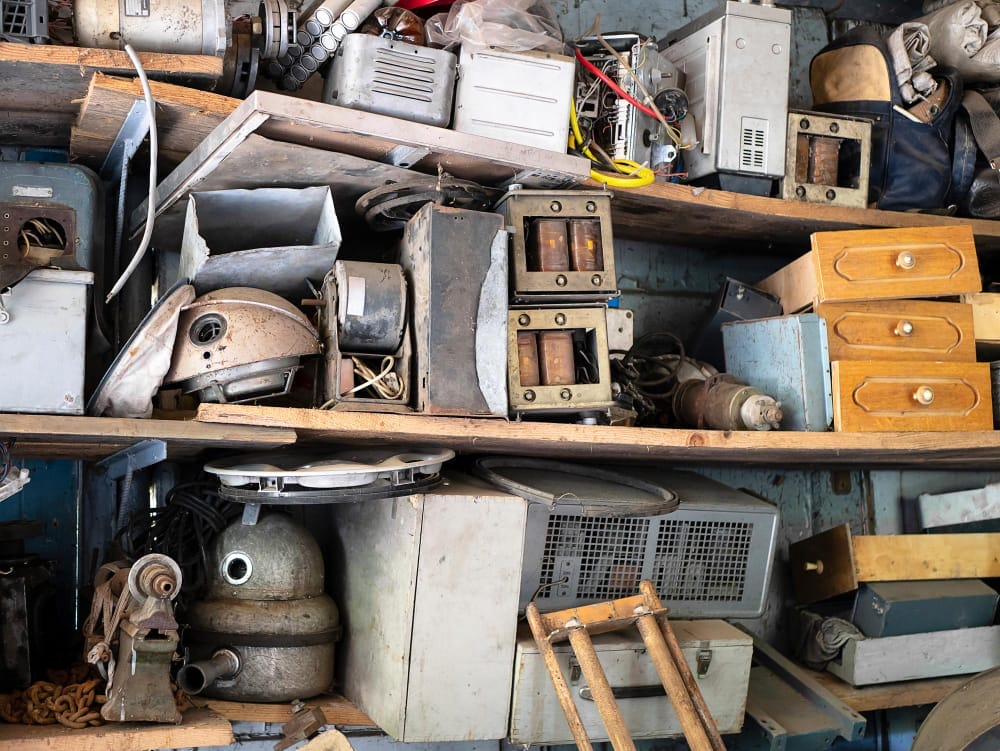
Open and supportive communication with family and friends is key to overcoming the isolation that hoarders may feel. Seeking support from a therapist, support group, or professional organizer can create a safe environment to address feelings of shame and isolation.
Long-term strategies to prevent relapse involve ongoing therapy, regular monitoring of the living space, and the development of healthy coping mechanisms. It is also important to establish a support network that can offer encouragement and practical assistance. Cleaning is not the solution to hoarding.
Engaging with support groups provides a sense of community and understanding. Professional organizers can offer practical skills and an objective perspective that is often crucial in the recovery process.
Real-life examples of those who have overcome hoarding can serve as inspiration and provide insights into effective strategies for change. Success stories often highlight the importance of persistence, self-compassion, and the support of others. Here's a case from one of our first customers, whom we were to assist with a severe hoarding situation for its elderly client:
The path to recovery is unique for each person, but the common thread among successful outcomes is the willingness to seek help, develop coping skills, and build a support network. For those struggling with hoarding, remember that change is possible, and the process does not have to be faced alone.
Whether it's through a local support group or the comfort of those who understand, there are paths to a brighter, clutter-free future. We converted it all in our Bio-One of South OC blog post on how to approach hoarding: Support Groups and Resources for Those Affected by Hoarding
If you're dealing with hoarding, or know someone who is, remember that professional help is available. At Bio-One of Oceanside, we understand the delicate nature of hoarding situations and approach each case with compassion, patience, and understanding.


Rodents can quickly turn your cozy nook into a menace. With their amazing fecundity and destructive chewing habits, a small rodent problem can escalate into a full-blown infestation, gnawing at not just your property but also your peace of mind. Whether you're a homeowner invested in creating a clean and safe family environment or a property manager, knowing the most efficient methods for cleaning up after rodents is critical.
An ounce of prevention is worth a pound of cure, and this couldn't be more true when it comes to rodent control! Here are some tips for preventing rodent infestations in your home:
Seal Entry Points
Rodents can squeeze through incredibly small openings. Use steel wool and caulk to seal any gaps or cracks in the foundation, walls, and around pipes.
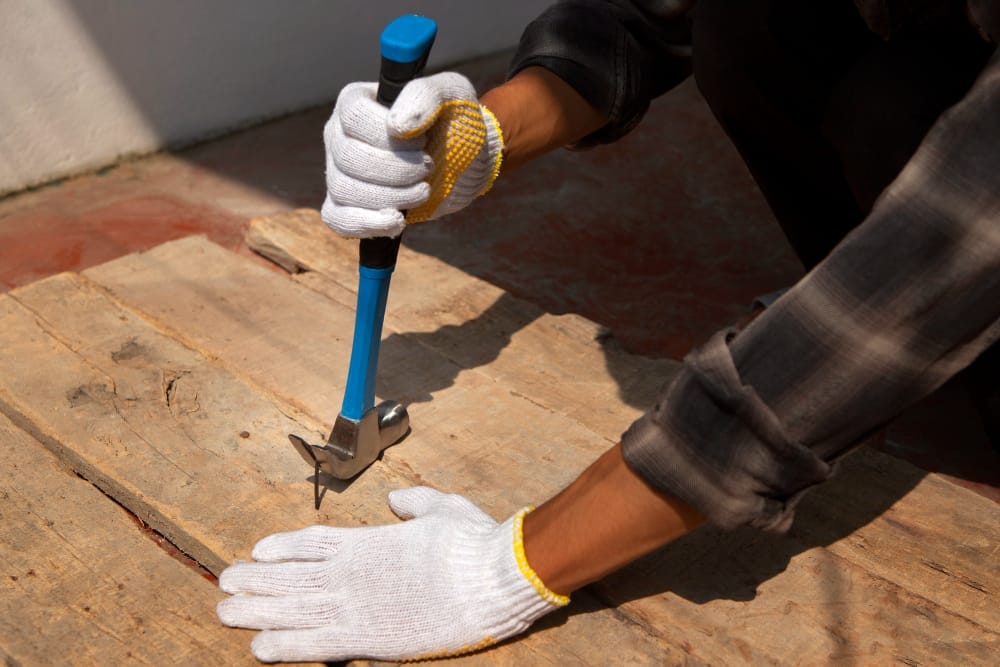
Keep a Tidy Home
Rodents are attracted to clutter and potential hiding spots. Regularly clean and organize storage areas. Store food in airtight containers, and eliminate water sources like leaky faucets.
Outdoor Maintenance
Trim overgrown trees and plants near your home that could serve as a highway into your property for rodents. Keep grass and bushes trimmed to deny them hiding places close to your home.
Learn more: 4 Ways to Rodent-Proof Your House | Bio-One of Oceanside
When prevention isn't enough, traps and baits are the next line of defense. It's important to use these tools with care and thought.
Choosing the Right Trap
There are different traps for different situations. Snap traps are effective for reducing a moderate rodent population, while electronic traps are a more humane option. Glue traps are a last resort for severe infestations.
Baiting Techniques
Use a high-protein bait that will attract rodents. Peanut butter, bacon, or chocolate are good options. Be sure to place the bait at the back of the trap to encourage the rodent to step onto the trigger.
Trap Placement
Place traps along walls, as rodents like to travel along edges. Check traps often and dispose of rodents with gloves to avoid direct contact.
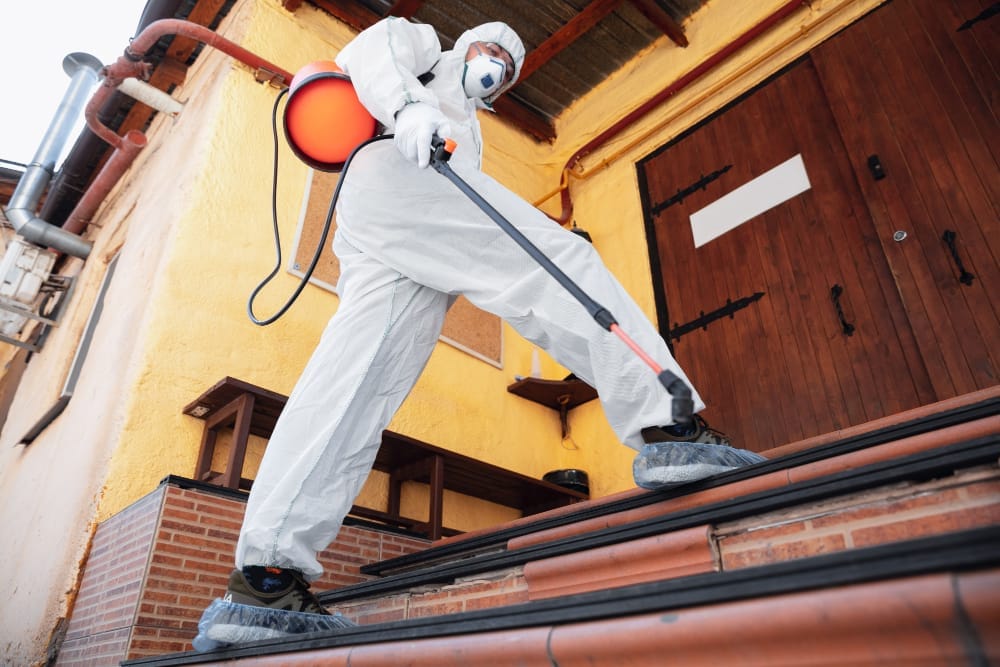
Sometimes, the situation is beyond what homeowners or property managers can handle alone. Professional pest control services can help when:
Size of the Infestation
If you've spotted several rodents or signs of a large infestation, it's time to call in the pros.
Specialty Species
Some rodents, like roof rats, can be particularly challenging to catch.
Risks
If there are health or safety concerns, such as aggressive rodents or inaccessibility to certain areas, professionals have the tools to handle these situations safely.
Learn more: 4 Rodent-borne Diseases and How to Remove Rodent Droppings | Bio-One of Oceanside
After the rodents have been removed, the work is not over. There’s still the matter of making sure your house is safe and disinfected.
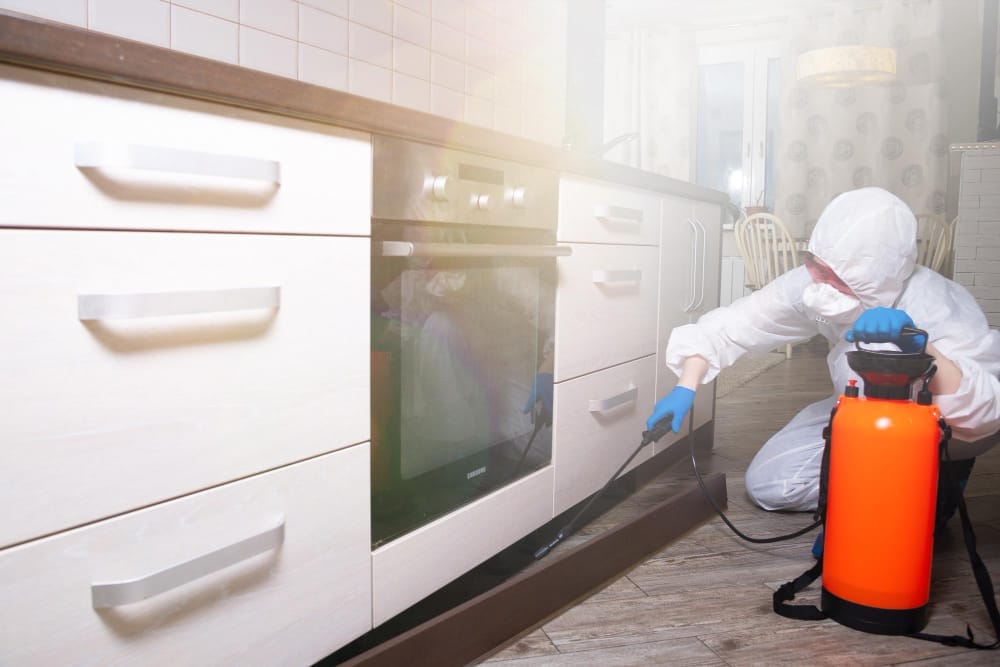
Personal Protective Equipment (PPE)
Always wear gloves and a mask before cleaning up after rodents. Their droppings and urine can spread viruses, so prevention is key.
Decontamination
Thoroughly clean and disinfect areas where rodents have been active. This includes all surfaces, from countertops to the insides of cabinets.
Learn more: Cleaning Up After Rodents: Proven Tips for Pest-Free Homes | Bio-One of Pittsburgh
Air Quality
If you've had a rodent problem, it's a good idea to test your home's air quality. Dust and particles from rodent droppings can become airborne and pose a respiratory risk.
From prevention to proper sanitation, each step is vital in ensuring that your home or property is rodent-free and safe. Regular maintenance, like frequent inspections, and touch-up sealing, is also key. If you find yourself in need of professional post-pest remediation cleanup or rodent droppings cleanup, Bio-One of Oceanside is here to assist. Our team can not only clean but also disinfect and decontaminate the areas thoroughly.
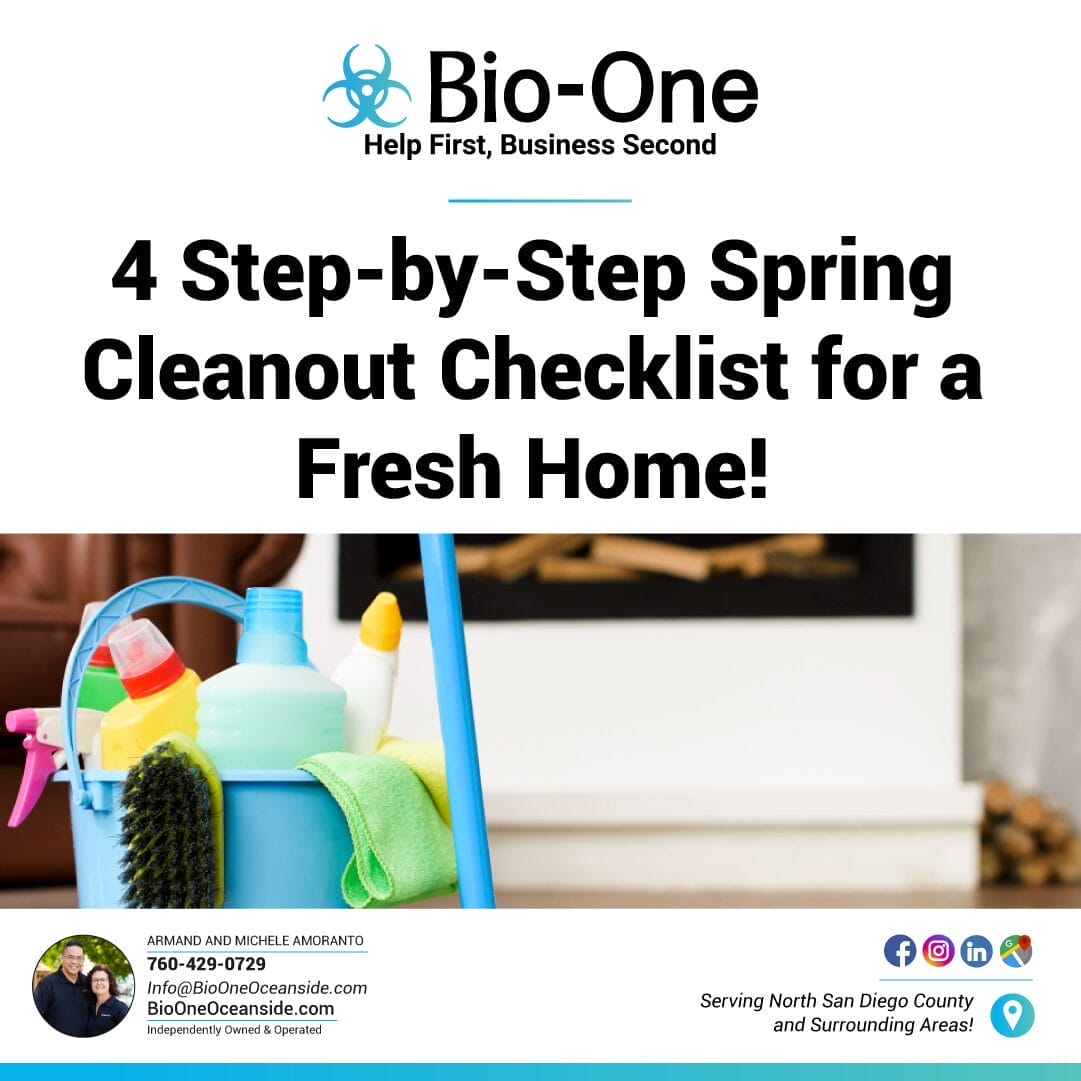
The arrival of spring is not just about longer days and warmer weather; it's an invitation to refresh our homes! Here's our spring cleanout checklist that will take you room by room through the process of transforming your house, and it's more than mere cleaning! Whether you're a meticulous homeowner, an occasional DIY-er, or a bustling family unit, these practical steps will leave your home sparkling, organized, and ready for the blooming season.
Before you start, take a moment to identify the areas in your home that need attention and set specific goals for each space. For example, do you want to declutter your closet? Deep clean your kitchen? Reorganize your living room? Having a clear goal in mind will make it easier to create a plan and stay motivated throughout the process.
Tips:
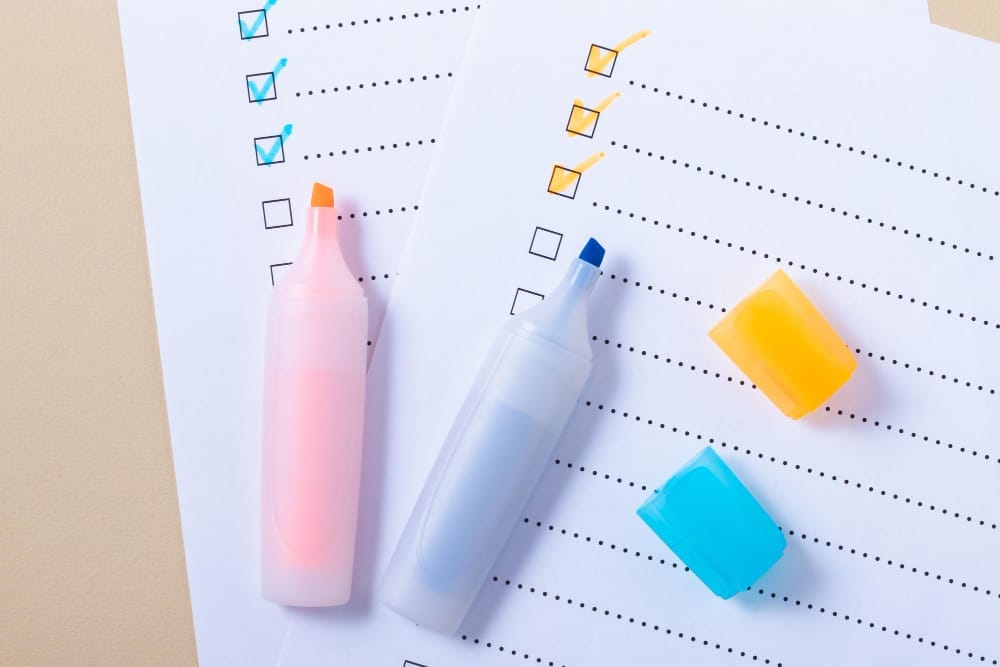
Use the four-box method to make decisions quickly about the items in your space. Label boxes or areas within a room with these categories and sort through your belongings, placing each item in the appropriate box. Be ruthless; if you haven't used something in over a year, it's likely time to part ways with it.
For items you decide to keep, invest in smart storage solutions. Utilize under-bed storage, wall-mounted shelves, and clear plastic bins to keep your belongings out of sight yet easily accessible. Think vertically to make the best use of your space, and don't forget about the potential of multi-use furniture with built-in storage.

Once the excess has been removed, it's time to get into the nitty-gritty. Start at the top and work your way down, dusting ceiling corners, light fixtures, and shelves. Vacuum or mop floors before moving onto surfaces like countertops, cabinets, and appliances. Don't forget to clean windows and mirrors as well.
Tips:
Clean windows, power wash your deck or patio, and sweep away debris from your yard. Don't forget the gutters—a winter of windblown leaves and precipitation could mean that they're now full of blockages.

We'll guide you through a comprehensive list for each room:
Learn more about getting started with your deep cleaning journey by visiting our friend’s blog at Bio-One of Modesto: The Beginner's Guide to Deep Cleaning Your Home with Bio-One
Invest in storage that complements your aesthetic while serving a functional purpose. Baskets, bins, and jars can keep small items contained and add an organized look to shelves and countertops. Labeling is your friend here — it not only looks tidy but also helps all family members find and return items to their proper place.
Establish an ongoing cleaning and organizing routine. Daily tasks like making beds, wiping down surfaces, and keeping up with dishes should become part of the family's habit. Knowing where everything goes makes it easier to maintain order, and a little effort each day prevents the need for another major cleanout.
The final step of your spring cleanout is arguably the most important—maintenance. After investing so much time and effort into refreshing your home, it's essential to keep it that way.
Make time for seasonal and bi-annual check-ins. Schedule a weekend every few months to go through the decluttering, deep cleaning, and organizing steps. This will keep your home from becoming overwhelming to tackle all at once.
The 15 minutes a day rule can be a game-changer. Allocate a small portion of each day to quick tasks, whether it's a quick dusting, sweeping, or reorganizing a drawer. These little bursts of tidying add up and can prevent you from feeling like you're constantly in cleanup mode.
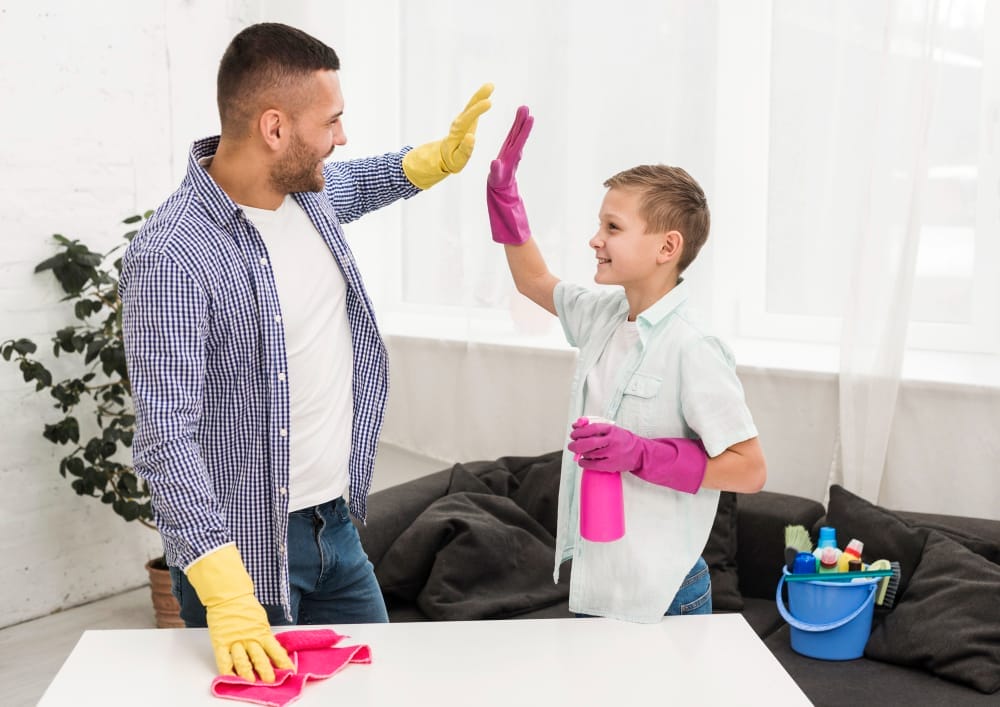
A clean home is a team effort! Assign tasks to each member of the household; even young children can be involved in picking up toys or their rooms. Having everyone participate not only lightens the load for you but also instills a sense of responsibility and pride in the home environment.
If you’re looking to involve your kids in the cleaning routine of the home, change the concept of cleaning as punishment, but as a key to living better!
If your spring cleanout checklist uncovers any unexpected messes, Bio-One of Oceanside is here to help. We offer professional cleaning and restoration services for all types of situations, from hoarding cleanup to biohazard remediation. We can handle even the toughest jobs! Contact us today for more information or to schedule a consultation.
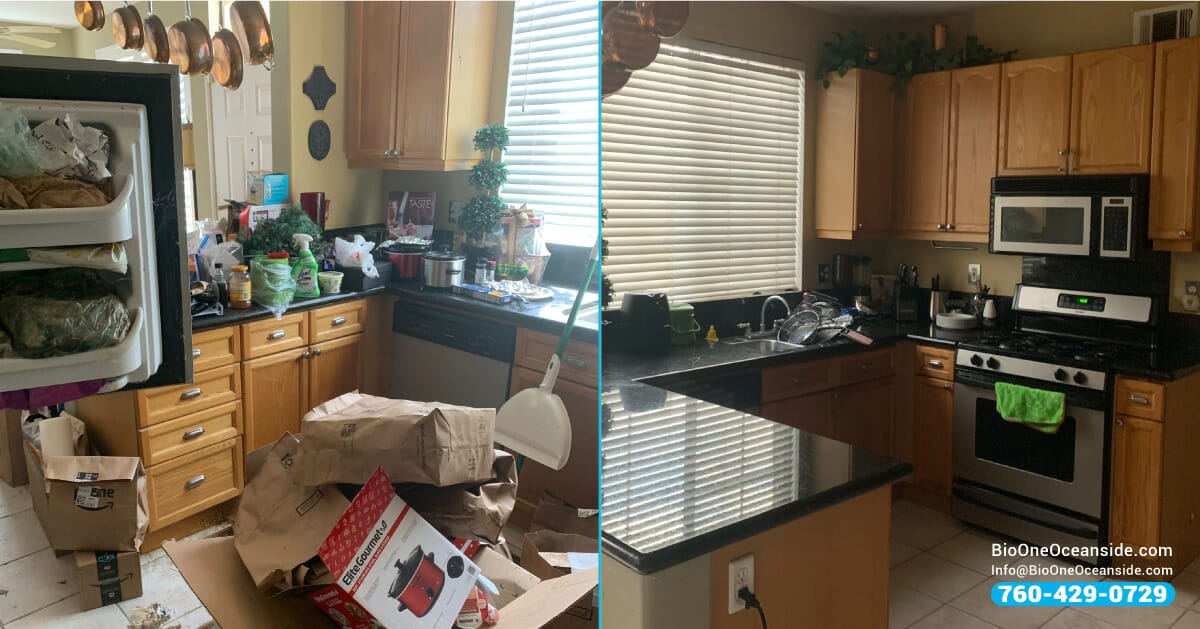
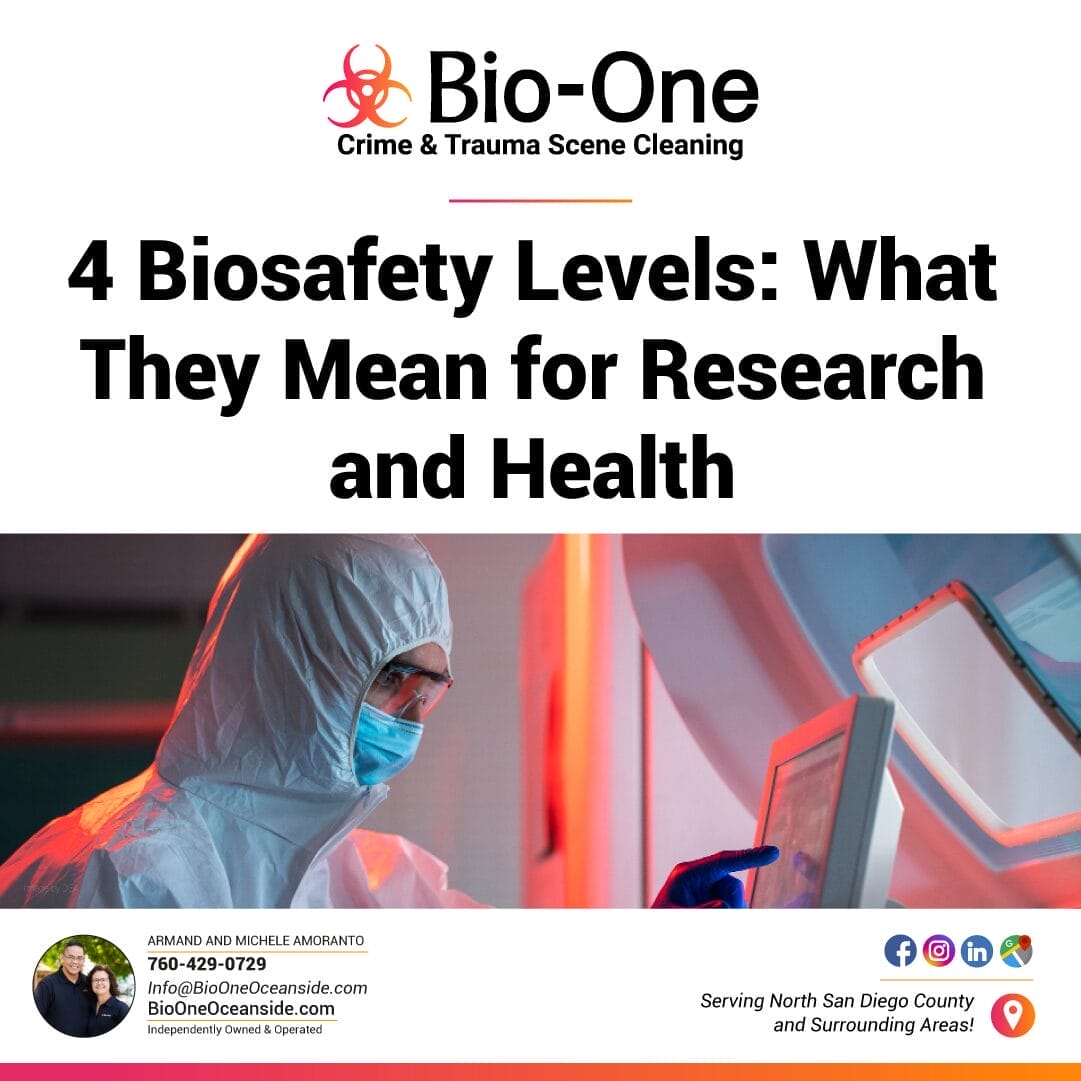
Imagine a scenario where a novel pathogen reaches a laboratory setting or a worst-case where a hazardous biological agent is intentionally released. What follows is the crucial dance between containing and mitigating the threat and preventing a widespread health crisis. This is the arena in which the 4 Biosafety Levels (BSLs) perform their critical role.
The biosafety levels are a strategic approach to safeguard public health, protect researchers, and maintain the integrity of scientific research. In this in-depth blog post, we'll walk you through the four levels of biosafety, outlining the specific requirements, and contextualizing their significant impact. Please keep in mind we are a biohazard cleanup company and are not liable for any decision-making based on this information.
The 4 Biosafety Levels are a hierarchical series of safety measures that provide a standardized way to manage the risk of working with biological agents. Ranging from BSL-1 to BSL-4, each level represents an increase in the complexity and rigor of practices, physical containment, and the safety equipment required to deal with potentially lethal pathogens. Labs around the world, regardless of their geographic location or specialization, consistently adopt these guidelines to ensure the application of best practices globally.

Adhering to biosafety levels is vital for laboratories, healthcare facilities, and even animal research centers as they handle the full spectrum of biohazards, from microorganisms that pose minimal threat to human health to those that can induce life-threatening diseases and against which no vaccine or therapy is available.
At the foundation of the biosafety pyramid is BSL-1, catering to agents not known to cause disease in healthy adults, although they can have impacts on immunocompromised individuals. For instance, some strains of E. coli or Bacillus subtilis fall under this category, where standard hygiene and laboratory practices are sufficient control measures. Laboratories operating under BSL-1 house open and ventilated workspaces with sink and eyewash stations, encouraging post-work decontamination routine.
Educational settings frequently utilize research environments that only require Biosafety Level 1 (BSL-1) measures, introducing students to microbiological techniques. However, even at this fundamental level, maintaining diligence is crucial. Lapses in safety practices due to complacency can significantly compromise biohazard containment.

Moving up, BSL-2 encompasses agents of moderate potential hazard to personnel and the environment. This includes more dangerous pathogens like Methicillin-resistant Staphylococcus aureus (MRSA) or hepatitis A, B, and C viruses which can cause varying degrees of illness in humans. Laboratories working within BSL-2 guidelines implement more stringent controls, including significant access controls and approved waste decontamination systems.
Personnel working in BSL-2 facilities receive special training and work within a controlled environment, often in biosafety cabinets where the pathogen and the researcher's respiratory safety are addressed. Additional personal protective equipment (PPE) is used, such as lab coats, gloves, eye protection, and face masks, to protect the worker against potential exposure through droplets or aerosols.
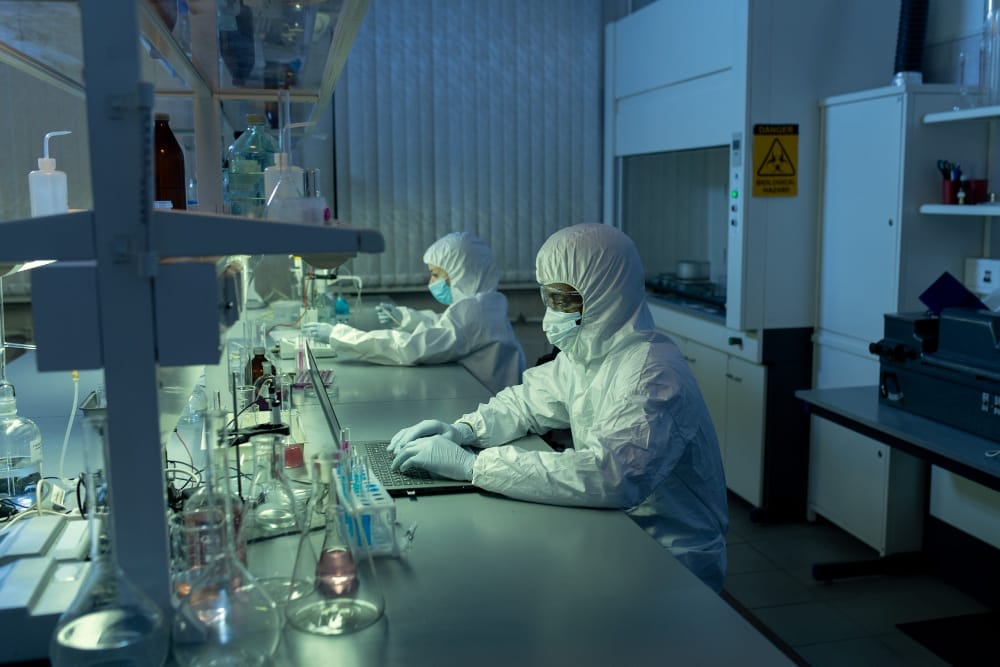
BSL-3 focuses on the containment of biohazards that are potentially lethal through inhalation, requiring labs to have primary and secondary barriers to prevent the escape of airborne organisms. Transmission of Mycobacterium tuberculosis occurs not only through inhalation but also through contact with broken skin and mucous membranes.
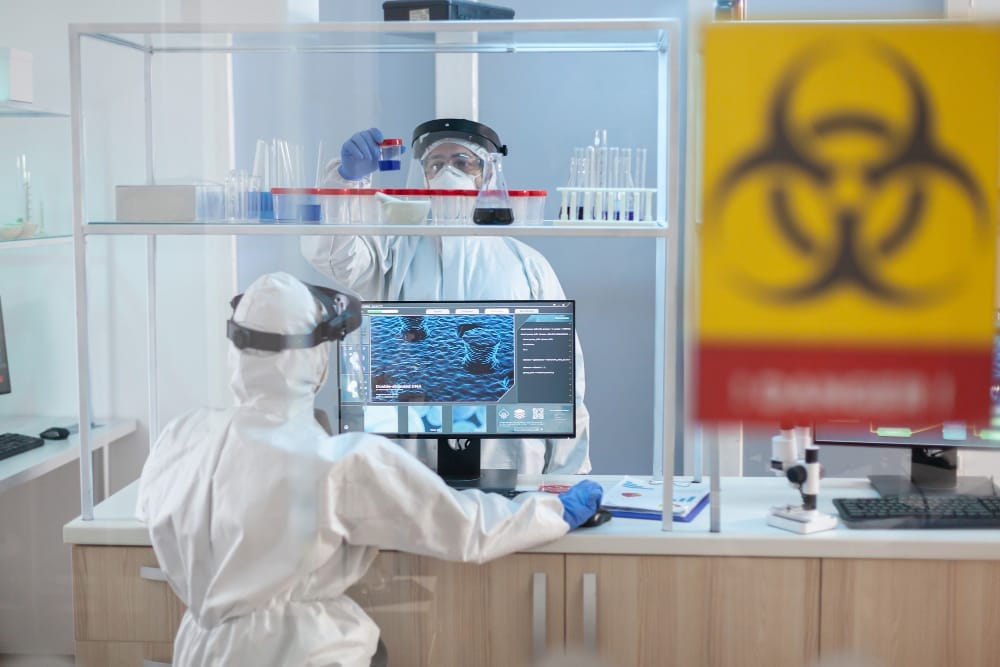
Specialized engineering features, including directional airflow and restricted personnel movement, outfit facilities at this level. Beyond this, BSL-3 facilities require thorough decontamination procedures for both equipment and laboratory surfaces, which often include the use of autoclaves for sterilization and certification of the air handling systems by a qualified industrial hygienist.
At the peak of the 4 biosafety levels hierarchy is BSL-4, intended for agents that pose an extreme risk of life-threatening disease, which are aerosol-transmissible and for which there is no available vaccine or therapy. Think of the deadly Ebola and Marburg viruses, which require complex procedures and a physically isolated environment to prevent any potential release.
Laboratories at this level are usually governed by national and international directives, with the majority functioning as high-containment facilities, housing pathogens in either a separate building or a secure zone with restricted access. Personnel working in BSL-4 labs undergo rigorous and comprehensive training on personal protection and safe operating procedures, with every action meticulously planned to mitigate the risk of exposure.

While the physical containment and engineering controls of the 4 biosafety levels are crucial, they are not the final word in hazard management. The integrity of the biosafety pyramid rests on the behaviors and practices of laboratory professionals and personnel. Regular training, knowledge updates, and a culture of safety are fundamental to effectively implement biosafety protocols.
In the event of a containment breach or human error, the details of these protocols can actively determine whether an incident remains localized or becomes a widespread outbreak. Consequently, investment in employee education, easy access to safety materials, and an environment that prioritizes open communication about potential risks should be at the forefront of any biosafety program.
If a biohazard release occurs, immediately contact Bio-One for rapid and thorough containment and cleanup. We specialize in biohazard and infectious waste cleanup! We not only understand the seriousness of the event but also have the expertise and equipment to handle the unique challenges that biohazards present.
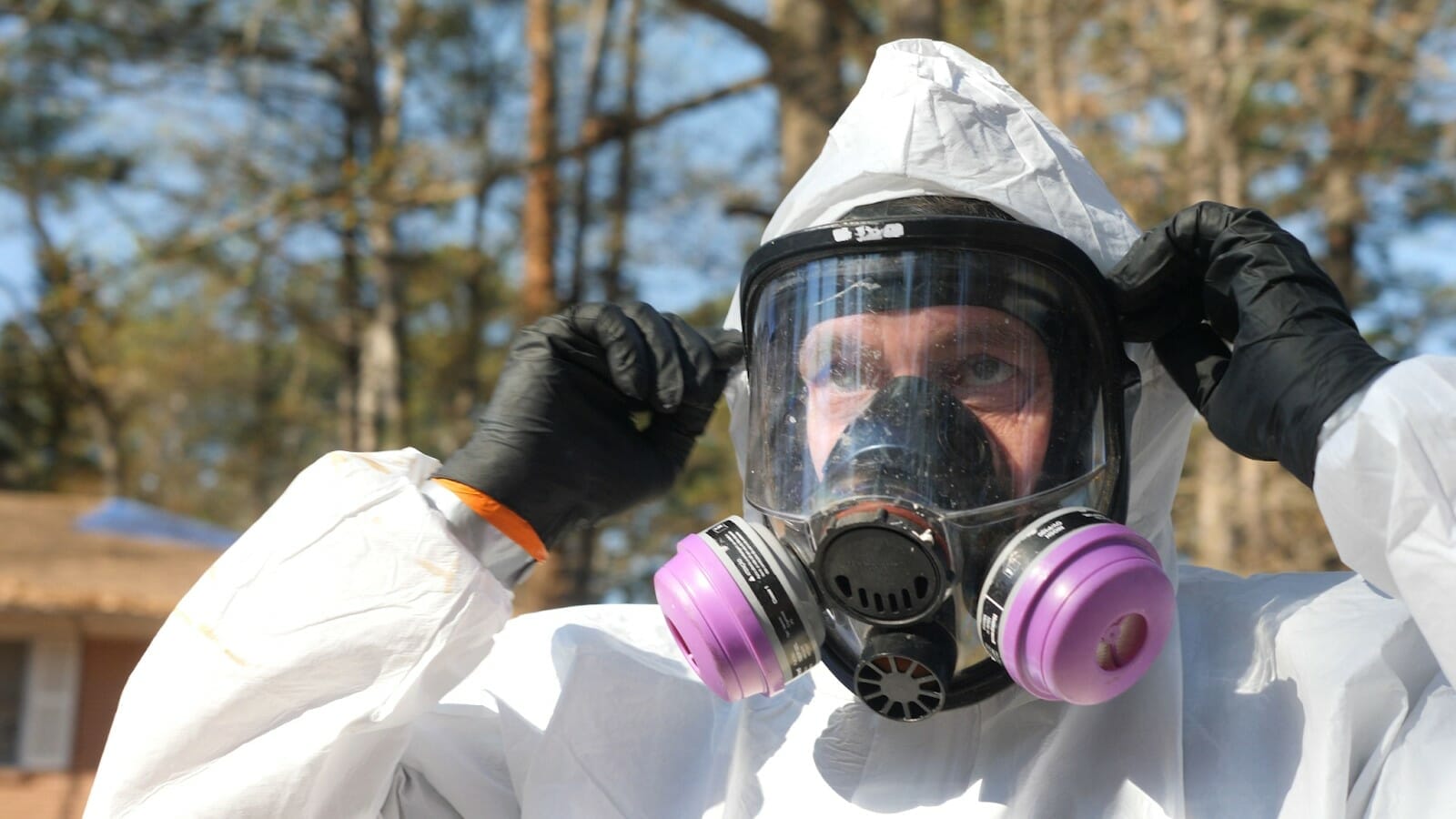
Whether you're an individual, a corporation, or a government entity, know that you're not alone. Contact us today for a free consultation.

Are you or someone you know struggling with a hoarding disorder? Does the idea of cleaning out spaces feel overwhelming and daunting? If so, Bio-One of Oceanside is here to offer some help. Our professional technicians are sharing hoarding clean-out tips to restore your home into a safe and livable environment.
Here are four helpful tips that our specialists recommend to make the process easier for everyone involved. From those directly impacted by hoarding to their families and property managers as well. With our specialized processes, guidance, and support, you’ll have what it takes to clear the clutter from any space while also maintaining sensitive items that hold personal meaning!
It can be easy to get bogged down by the mess, but with a little planning, you can tackle it like a pro. Start by making a plan of attack, considering some of the following aspects:
Making a plan will help you stay on track and ensure that nothing gets overlooked during the cleanup process.
When it comes to personal items, it's important to remember that everything we encounter has a certain value attached to it, sentimental or purely monetary. Perhaps some of the items collected during the cleaning process could be useful to someone else and if we are not careful, we may end up damaging them. Use the right cleaning tools and materials for each item, including clothes or brushes!
We take great pride in providing a thorough service that leaves our clients satisfied with their newly organized space. We are also conscious of the environment, so we always strive to recycle and donate as much as possible. After all, there is no need for unnecessary waste!
One simple and effective way to keep your belongings in order is by using clear containers or bins. This way, you can easily see what’s inside without having to sort through the clutter every time you need something.
We also suggest investing in organizational tools like shelving units and hooks so that items can be kept off of the floor and put away neatly. A cluttered space is not only unappealing but it can be dangerous as well, as tripping over something is a much greater risk than if everything is in its proper place.
Labeling items can also help keep you organized and make it easier to find what you need when you need it. You can use sticky notes or labels to mark which box contains what items. This way, instead of having to go through several boxes to find what you’re looking for, you can just check the label and know exactly which box it is in. Finally, getting rid of items that are no longer necessary or useful will help keep your space organized. If you don't use an item often, get rid of it!
Hoarding can be a daunting challenge to tackle on your own. It's understandable to feel overwhelmed and unsure of where to start. That's why at Bio-One of Oceanside, we're here to help. We specialize in hoarding clean-outs and understand the complex emotional ties that come with letting go of personal possessions.
Our team approaches each job with compassion and professionalism, providing support every step of the way. Don't let hoarding take control of your life any longer. Follow our hoarding clean-out tips and do not hesitate to call us if you need help!
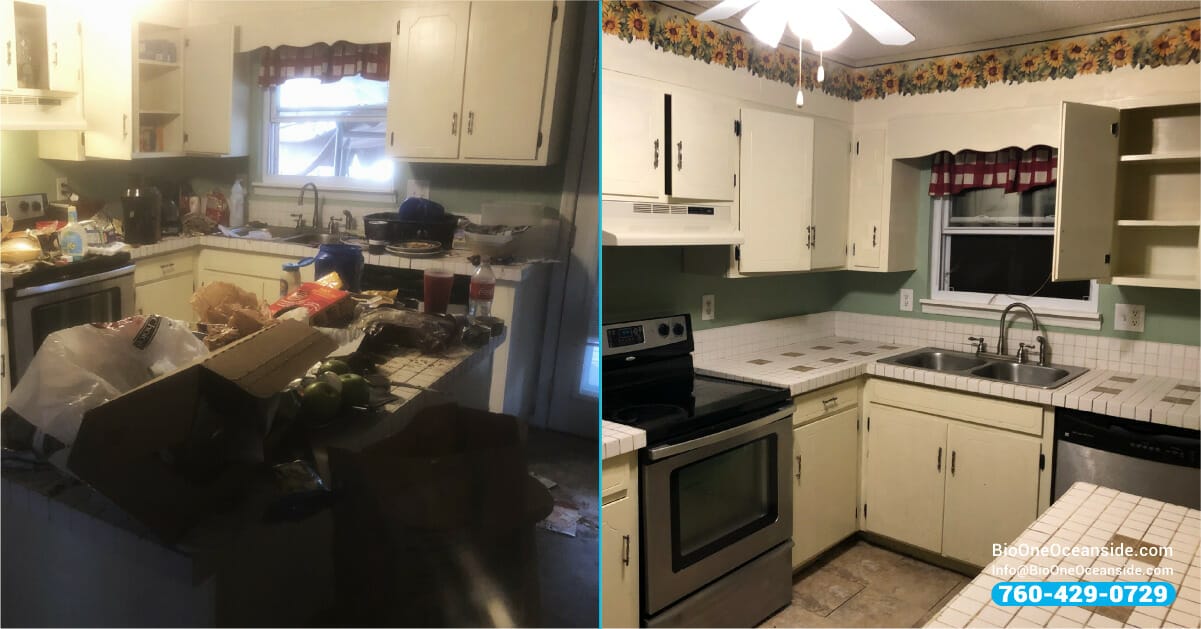
Bio-One of Oceanside is the #1 Disinfection, Sanitation, and Decontamination Company in North San Diego County, providing professional, industry standards services in all kinds of extreme scenarios:
Bio-One of Oceanside springs into action to assist survivors when a traumatic event occurs. We work with local law enforcement, emergency responders, victim advocacy organizations, hoarding task forces, apartment communities, and insurance companies to ensure that you receive the most outstanding service feasible.
We have been an independently owned and operated business since August 2020 to help our community through difficult and unexpected situations. Our certified technicians are caring, compassionate, and discreet, and we are ready to help you in your most significant time of need.
Bio-One is a proud member of the Carlsbad, Oceanside, and Vista Chambers of Commerce. We proudly serve all North San Diego County areas, including Oceanside, Carlsbad, Vista, Fallbrook, Escondido, San Marcos, and Bonsall.
We also serve the Southern Orange County cities: San Clemente, Dana Point, Rancho Mission Viejo, Laguna Niguel, Ladera Ranch, San Juan Capistrano, Aliso Viejo, Laguna Woods, Laguna Beach, Lake Forest, Rancho Santa Margarita, Irvine, and Costa Mesa.
Our services are available 24/7, 365 days a year. Give us a call at 760-429-0729.
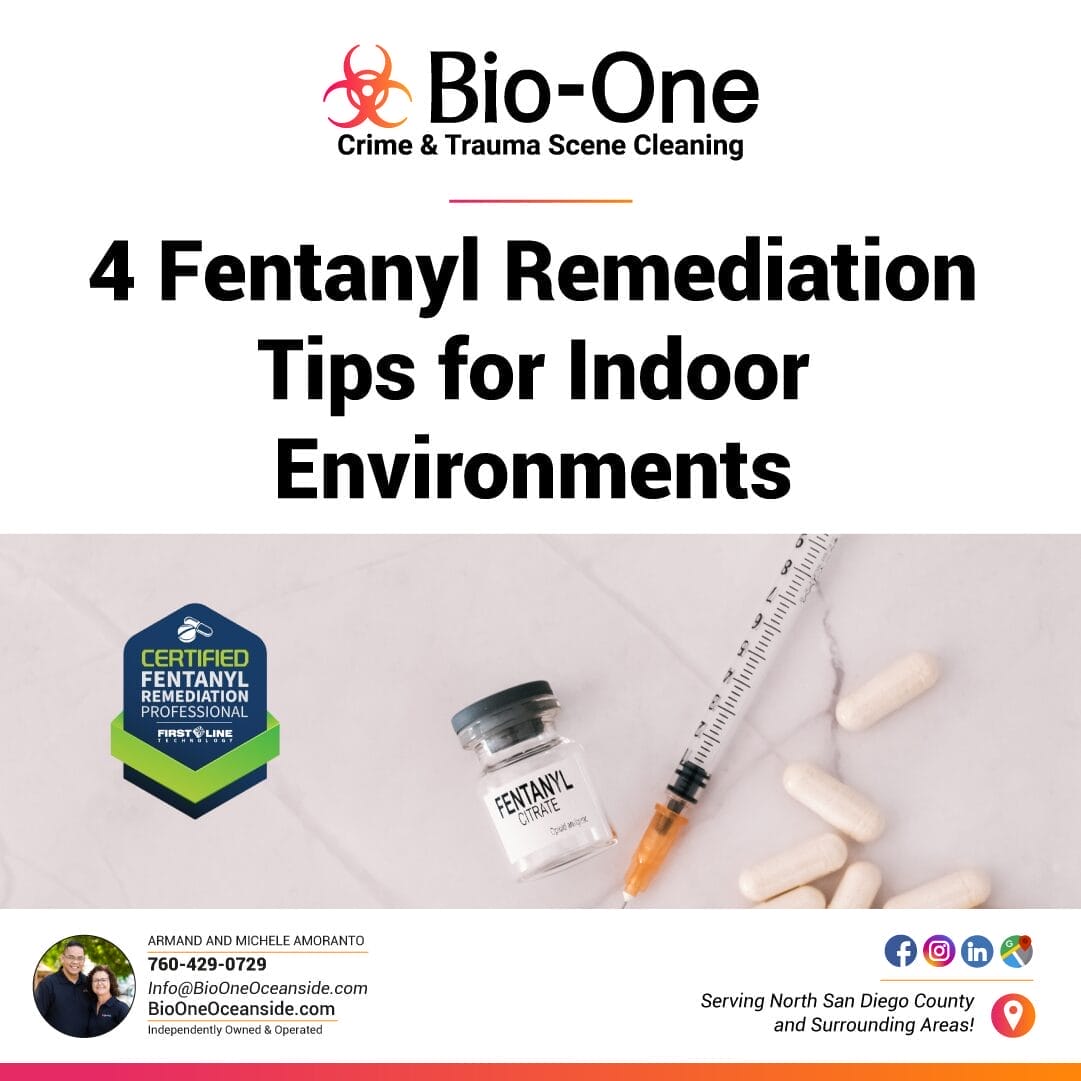
Fentanyl contamination has become a pressing concern across the United States, posing an unprecedented risk to public safety. This potent synthetic opioid is 50 times more powerful than heroin, and even the tiniest amounts of Fentanyl can lead to severe health consequences. Exposure to Fentanyl can occur through inhalation, ingestion, or skin contact, making it crucial to understand how to remediate indoor environments contaminated by it. Here are four tips to help you effectively address Fentanyl remediation in your home or business.
The most important rule when dealing with a Fentanyl contaminated space is to avoid direct contact. This includes not touching the area directly, and staying away from any items that have been affected, such as furniture or clothing. Touching an area contaminated with even trace amounts of Fentanyl can lead to serious health risks, so it's best to leave it alone and seek professional help.
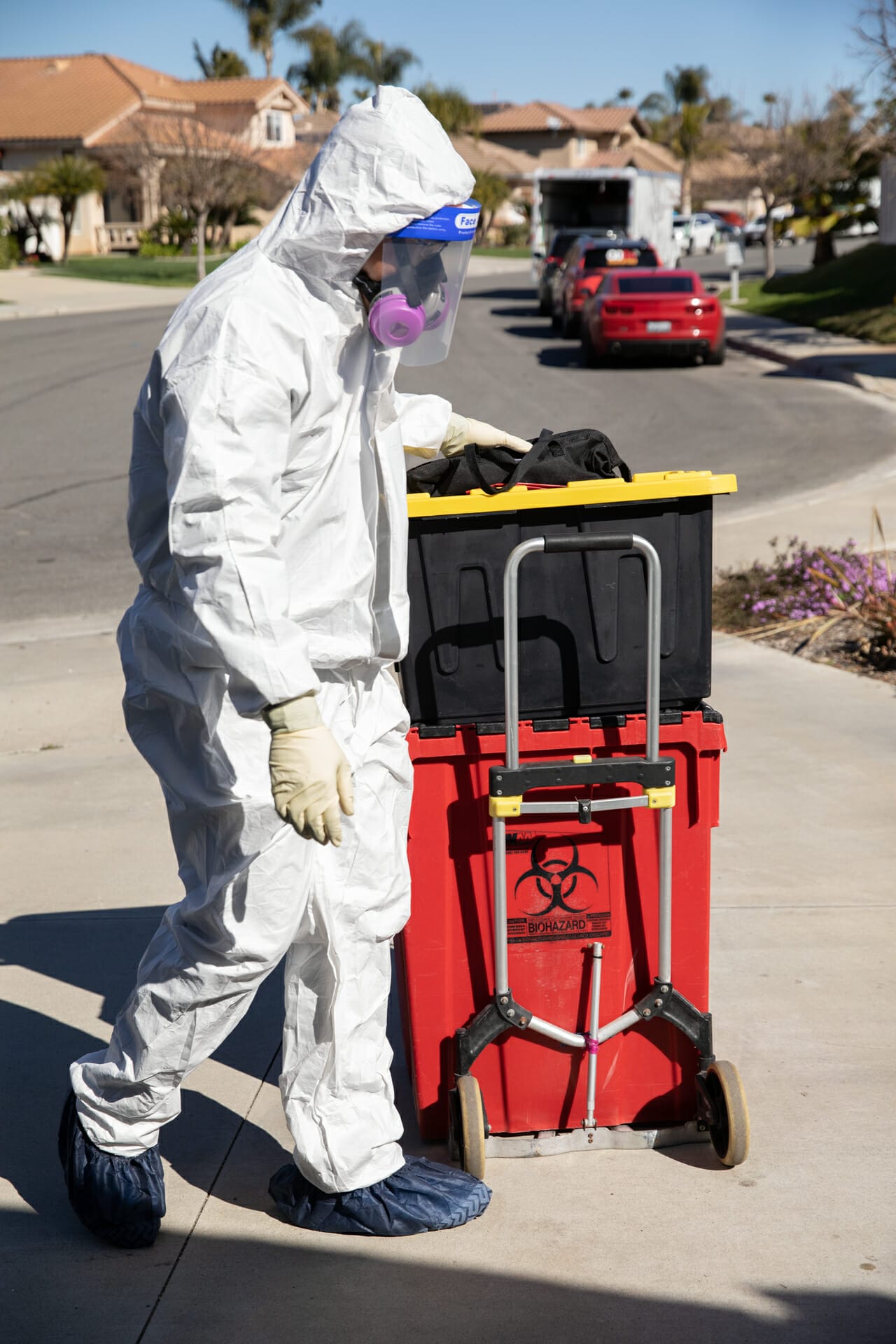
A thorough inspection of your indoor environment is necessary to determine the extent and location of the Fentanyl contamination. Afterward, it is essential to isolate the affected areas to prevent the spread of contamination to other parts of your home or business. Post warning signs to alert people to the potential hazards to ensure that everyone in the building knows to stay away from these areas.
Must read: How can you help someone having a Fentanyl overdose?
Your local law enforcement team can provide guidance on how to proceed with remediation and cleaning processes.
Due to the complexities associated with Fentanyl remediation, it is highly recommended to seek the help of a certified professional remediation company for clean-up and disposal. At Bio-One, we follow all safety guidelines and techniques to ensure that your space is safe to inhabit again.
Here are some reasons why Fentanyl has become such a big concern:
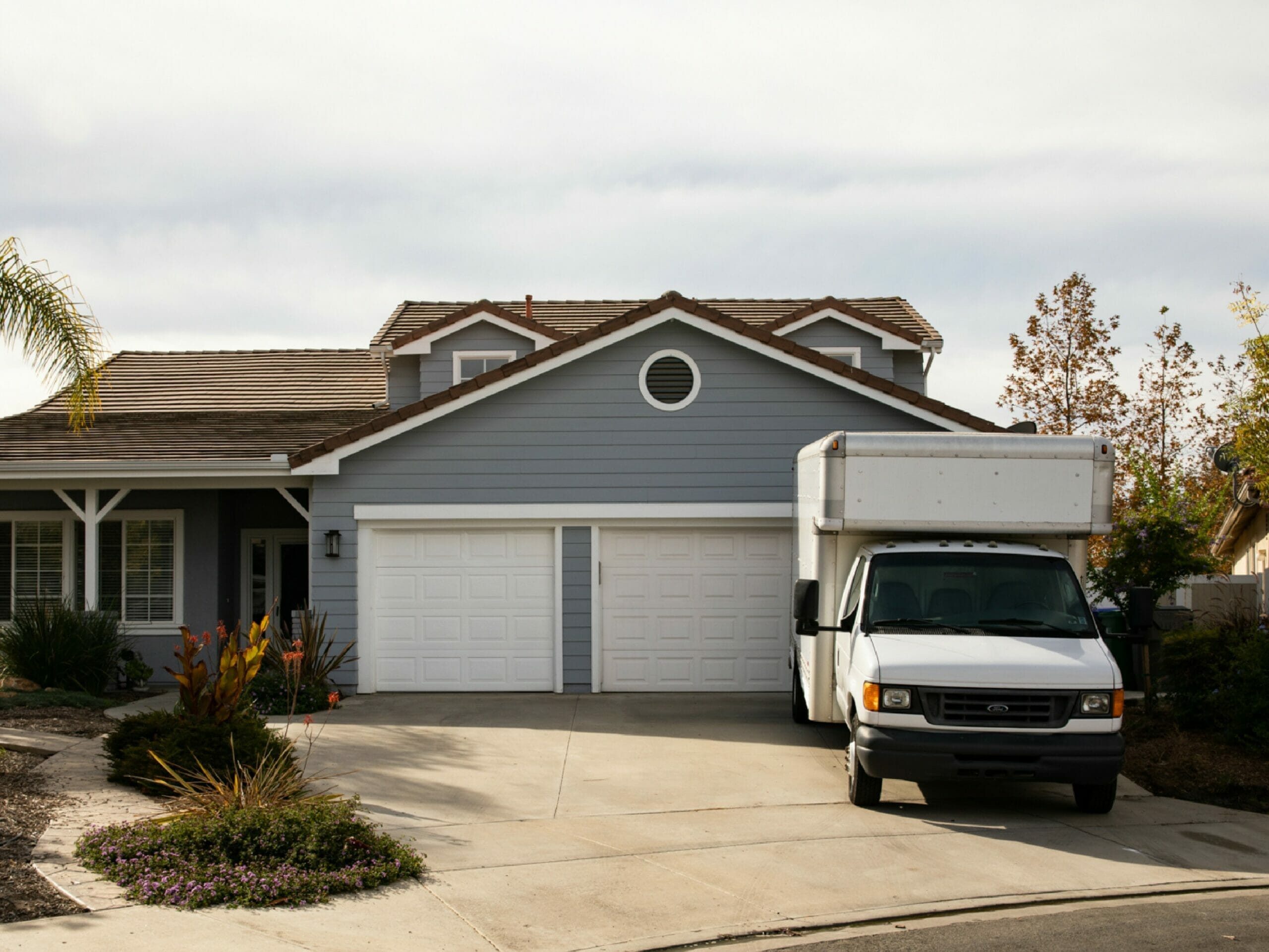
Fentanyl contamination is a serious and hazardous situation that requires thorough remediation by experienced professionals like Bio-One. Remember to seek professional help, identify and isolate contaminated areas, and let us dispose of contaminated materials safely. Following these tips will help keep your home or business safe and protected from the risks of Fentanyl exposure. Contact us today at Bio-One to learn more about how we can assist you or a loved one.

When we allow things to pile up in our homes or businesses, it can result in numerous negative consequences. One of which is the accumulation of dirt, dust, and debris. If you are dealing with a hoarded property, or you find yourself looking for alternatives to deep cleaning items and furniture after hoarding in the property, the starting point can be rough. That's why we've put together this article to give you four tips for deep cleaning items and furniture, with guidance on how to restore or discard them, if necessary.
Cleaning a heavily cluttered or hoarded space can be a challenging endeavor. It's crucial to make a plan before diving into the cleaning process. Break down the space into manageable portions that you can tackle one at a time. Write down the cleaning supplies you'll need, and enlist help if necessary. This list must include, at least, the following:
Trust us. Having a plan will save you time, avoid stress, and ensure that you don't miss any areas that need attention.
Image by mdjaff on Freepik.
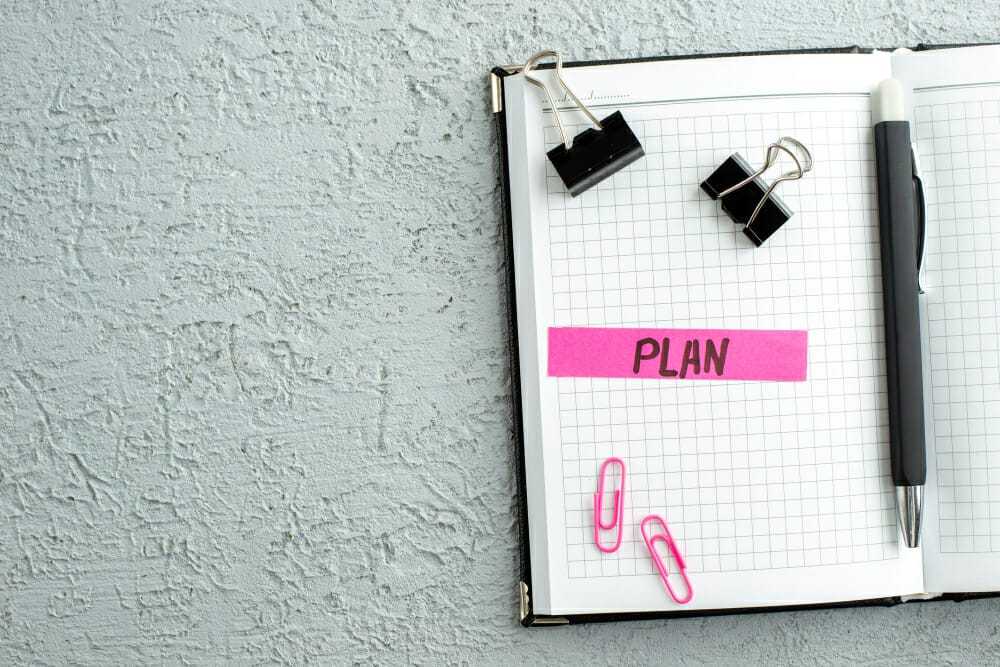
As you work through the hoarded items and furniture, take the time to declutter and sort the rooms and whatever might be inside some of that furniture, like drawers, cabinets, and closets. Decide what items are worth keeping, donating to charity, or tossing in the trash. Here are some tips for decluttering:
Deep cleaning hoarded items and furniture requires specific cleaning supplies. Start by dusting the items with a microfiber cloth to remove any loose dirt and debris. For specific items, here are some tips:

By using the right cleaning supplies and techniques, you can effectively clean up any items that might have been impacted by mold, deep seepage of grime, or pests. Know that, in some cases, items can be unsalvagable.
Image by alexkich on Freepik.
Cleaning a hoarded space can be time-consuming, difficult, and in some cases, overwhelming. Don't be afraid to ask for help from professionals or friends and family. A hoarding cleanup company can provide the expertise and resources needed to deep clean items and furniture safely and determine whether it's safe to keep some of them. Remember that seeking help is okay and can make the entire process more manageable.
Starting with a plan, decluttering and sorting, using the right cleaning supplies, and enlisting help are all crucial steps in the process. At Bio-One of Oceanside, our team of trained professionals is ready to assist with all your hoarding cleanup needs. Contact us today for more information and to schedule a consultation. Don't let hoarding take over your life and home. We're here to support you every step of the way.
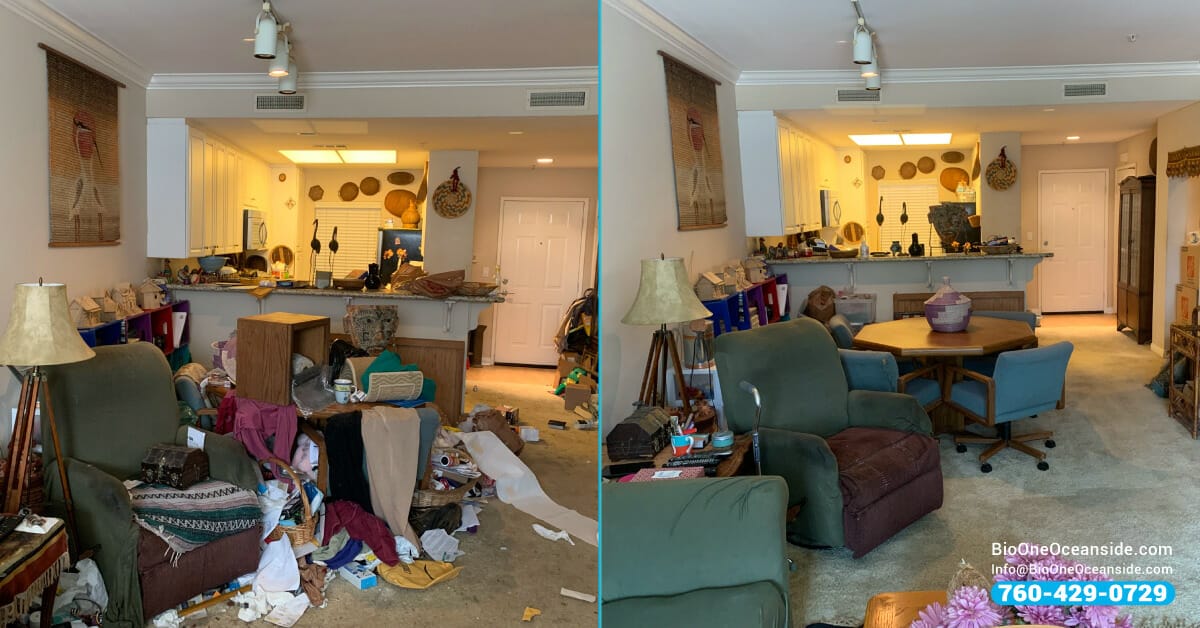
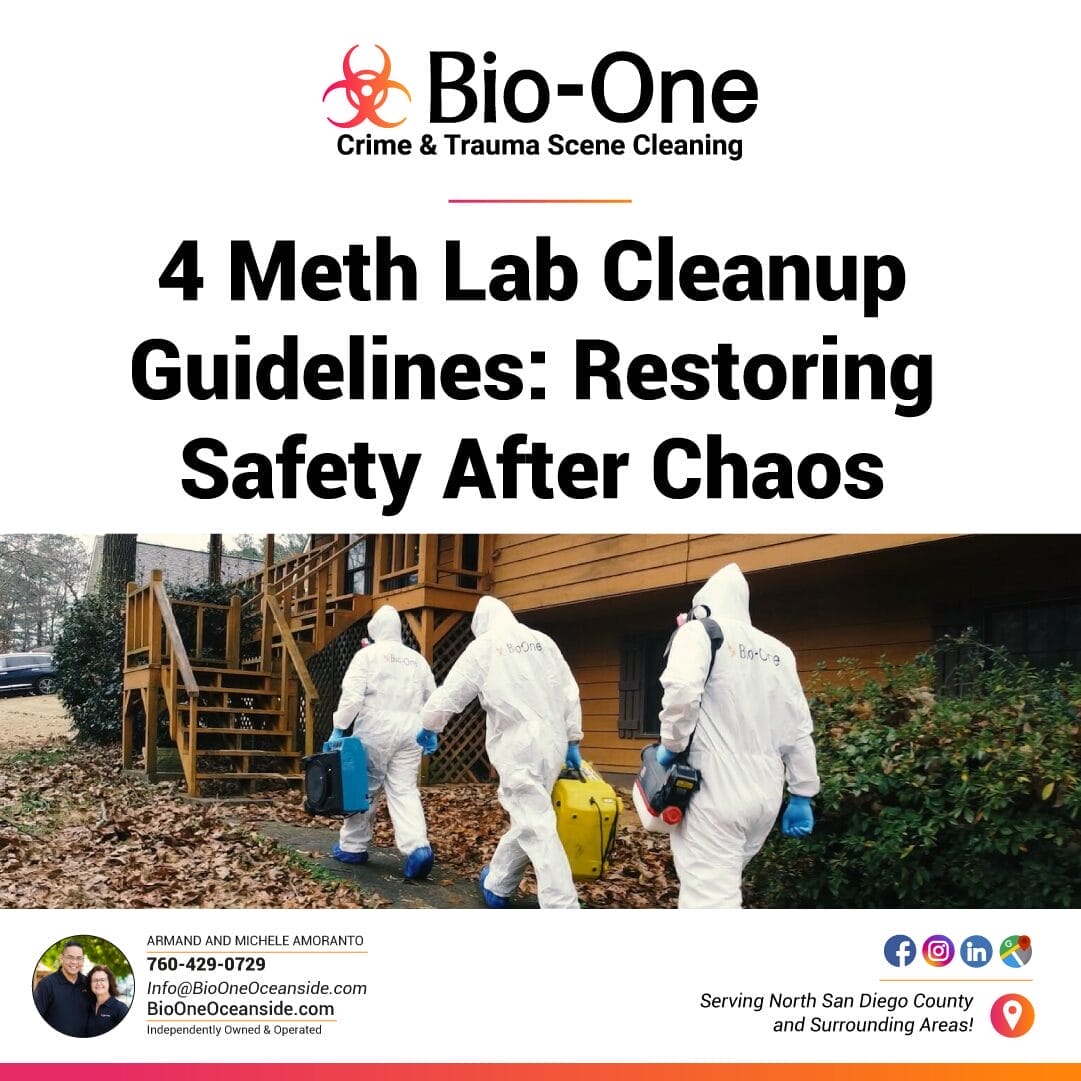
Methamphetamine production poses a serious threat to public health, and the remnants left behind in a clandestine meth lab can continue to endanger individuals long after production ceases. For hazmat professionals, environmental safety inspectors, realtors, property managers, and homeowners wondering how to clean a meth lab, we'll explore the best practices for ensuring a thorough and effective cleanup, from the initial assessment to achieving a certified clean status.
Disclaimer: It's critical to understand that the cleanup and restoration of properties used as meth labs require the expertise of a professional biohazard cleanup company. These companies possess the necessary certifications, proper insurance, and technicians specifically trained in OSHA's safety standards for handling hazardous materials. Due to the severe health risks and legal implications associated with meth lab contamination, individuals should not attempt to clean these environments on their own
A meth lab is not just a manufacturing site; it's a source of long-term health hazards. The volatile and toxic chemicals used in meth production can saturate walls, furniture, and ventilation systems, contaminating every corner of the property. Post-lab, these contaminants pose significant health risks, particularly when exposed to heat and moisture, which can reactivate residues and release toxic vapors into the air.
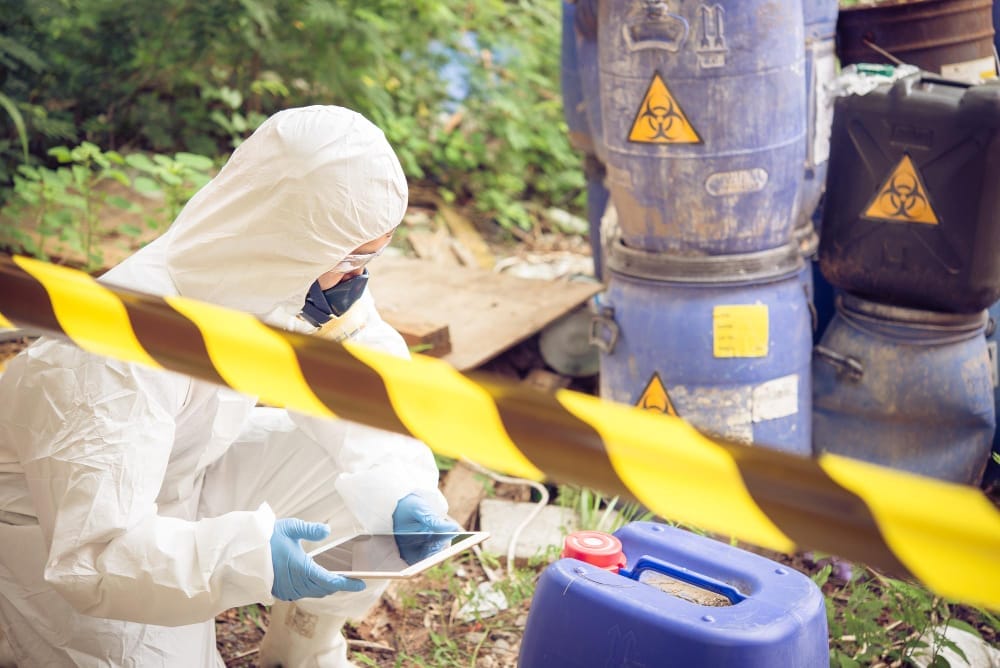
Professional meth lab cleanup is non-negotiable; it's a critical step in ensuring the property is safe for habitation. Not only that, but it's also a legal requirement in most jurisdictions.
The initial assessment sets the stage for the entire cleanup operation.
Hazmat professionals must conduct a thorough inspection to identify all potential meth lab components and areas where contamination is evident or likely. This includes examining all spaces known and unknown to the property owner, as well as discovering any hidden cavities or structural damage that may have been used for drug manufacturing and that could be contaminated.
Once contaminated areas are identified, it's essential to assess the degree of contamination. Factors such as the quantity and type of chemicals used, the condition of the former lab, and the properties of the surfaces that have been exposed to the methamphetamine production process will influence the level of contamination.
Hazmat teams use a variety of techniques, from visual inspections to advanced testing, to determine the scope of the problem. This assessment not only guides the extent of the cleanup but also helps in devising appropriate safety protocols for cleanup crews.
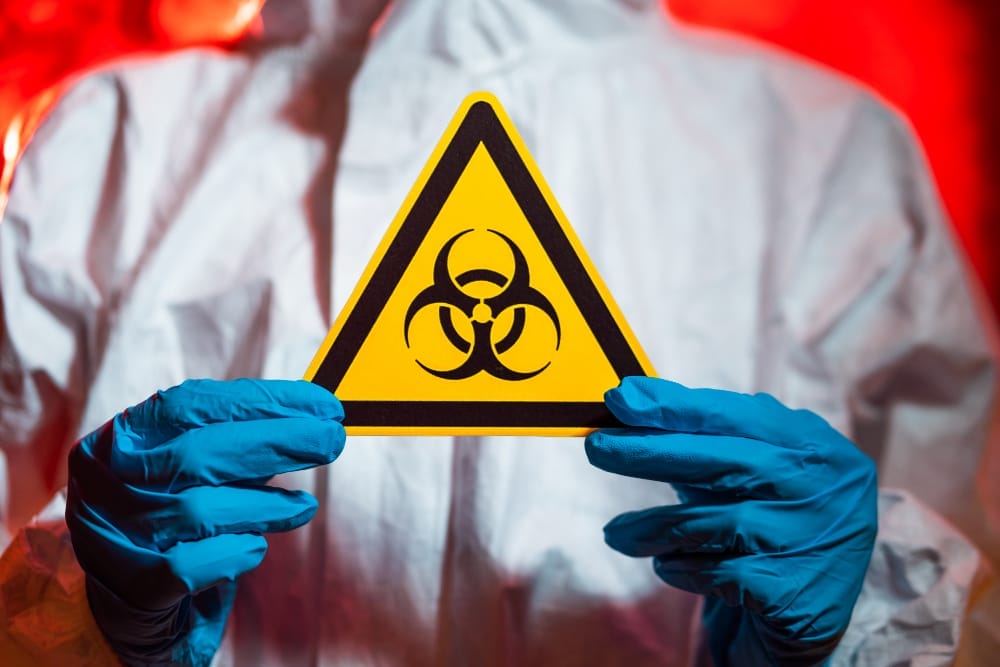
With the assessment complete, cleanup procedures can be implemented.
The first step in meth lab cleanup is the removal of all hazardous materials. This includes not only the obvious remnants of the manufacturing process, such as chemical precursors, solvents, and waste but also any contaminated items such as cookware, appliances, and furniture.
The next critical step is thorough decontamination. This is not a simple cleaning job; it requires specialized knowledge and equipment. All surfaces must be cleaned using appropriate decontamination solutions and techniques that can break down, neutralize, or remove residual chemicals.

Technicians typically dismantle, clean, and decontaminate them, followed by conducting remediation to ensure the airflow is safe and uncontaminated.
Technicians take surface samples from various areas to measure the level of residual contamination. These samples, generally analyzed using high-performance liquid chromatography or gas chromatography-mass spectrometry, provide quantitative data on the presence of methamphetamine and precursor chemicals.
In addition to testing for methamphetamine residue, Bio-One takes the cleanup process a step further by also testing for traces of other drug residues, including fentanyl. Given fentanyl's potency and the heightened risks associated with exposure, this level of thoroughness ensures an even safer environment post-cleanup. Handling fentanyl contamination requires precise, expert protocols to protect both the clean-up technicians and the occupants returning to the premises.

After cleaning the property and taking samples, technicians must perform structured testing to confirm the success of decontamination. This independent verification is crucial; it provides confidence that the property is safe for habitation and legally compliant.
The final step is to document the entire cleanup process and obtain certification attesting to the property's safety.
Maintain a detailed record of the cleanup process, which includes assessing the site, undertaking procedures, and documenting test results. This documentation not only provides evidence of the diligent cleanup effort but may also be necessary for future property owners.
Upon successful completion of the cleanup and verification steps, the property should be issued a certificate of safety. Philanthropically, ensuring the environment's safety also involves guiding residents or future owners on recognizing signs of illegal drug activity.
Disclaimer: The guidelines provided above serve as an example of the typical process how to clean a meth lab. They should not be interpreted as the standard practices of Bio-One of Oceanside. For specific protocols, services, and practices, please consult directly with Bio-One of Oceanside.
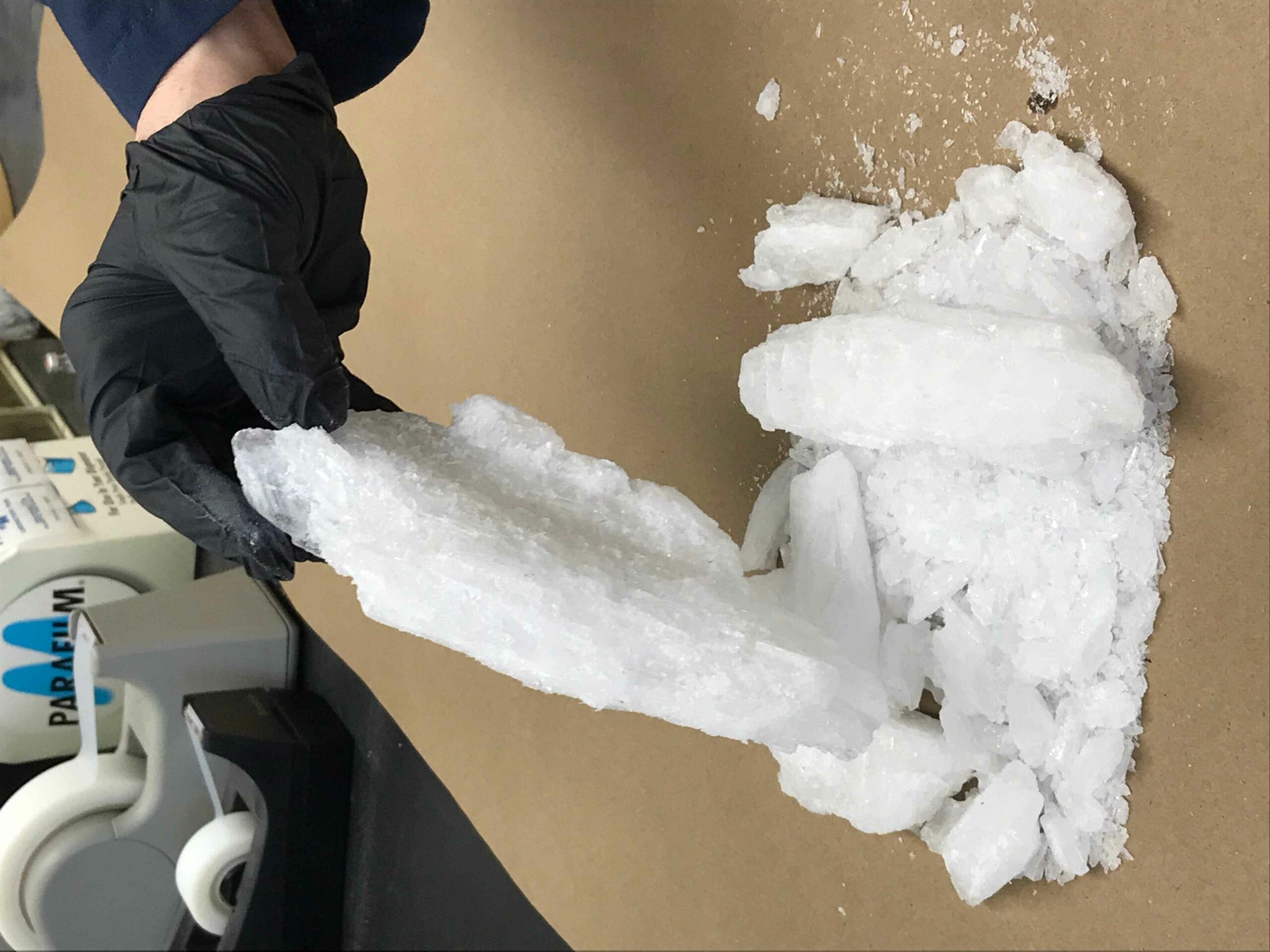
Meth lab cleanup is a complex and highly regulated process that demands expertise, patience, and thoroughness. The guidelines outlined here are an example of the work done by professionals to safeguard you from long-term exposure to harmful chemicals. However, it is essential to select a reputable and experienced cleanup company for this task.
Bio-One of Oceanside has specialized in crime scene and meth lab cleaning services for several years, serving commercial and residential clients across North San Diego County and Southern California. If you suspect that your property may have been used as a meth lab or if you feel unsure how to clean a meth lab, do not hesitate to contact Bio-One of Oceanside!